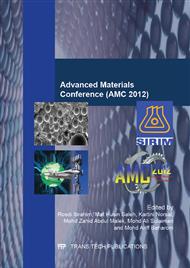[1]
German R.M. & Bose A., Injection Moulding of Metals and Ceramics. Metal Powder Industries Federation. (1997) 3-10.
Google Scholar
[2]
Merhar J.R., Overview of Metal Injection Moulding'. Metal Powder Report; 45(5) (1990) pp.339-342.
DOI: 10.1016/s0026-0657(10)80242-5
Google Scholar
[3]
Liu Z.Y., Loh N.H., S.B. Tor and K. A. Khor, Characterization of Powder Injection Moulding Feedstock, Material Characterization 49 (2003) pp.313-320.
DOI: 10.1016/s1044-5803(02)00282-6
Google Scholar
[4]
Chung C.I & Rhee B.O., Requirements of binder for powder injection moulding,. Compending Metal Injection Moulding, vol 2 (5) (1987) pp.269-77.
Google Scholar
[5]
C. Mutsuddy & R. G. Ford, Ceramics Injection Moulding, Champion Hall, London (1995).
Google Scholar
[6]
R. M. German, A. Bose, Injection Moulding of Metals and Ceramics, MPIF, Princeton, New Jersey, 1997.
Google Scholar
[7]
Dihoru, L.V., Smith, L.N., and German, R.M. , Experimental analysis and neural network modelling of the rheological behaviour of powder injection moulding feedstock formed with bimodal powder mixtures, Powder Metallurgy, Volume 43 No.1, (2000) pp.31-36.
DOI: 10.1179/pom.2000.43.1.31
Google Scholar
[8]
M. Khakbiz, A. Simchi, R. Bagheri, Analysis of the rheological behavior and stability of 316L stainless steel-TiC powder injection molding feedstock,. Materials Science and Engineering A 407. (2005) pp.105-113.
DOI: 10.1016/j.msea.2005.06.057
Google Scholar
[9]
Huang,B., Liang,S., and Qu, X., The rheology of metal injection molding, Journal of Materials Processing technology, Vol.1237 (2003) pp.132-137.
DOI: 10.1016/s0924-0136(02)01100-7
Google Scholar
[10]
Karatas, C., Kocer, A., Unal, H.I., and Saritas, S., Rheological properties of feedstock prepared with steatite powder and polyethylene-based thermoplastic binders", Journal of Materials Processing Technology, Vol 152 (2004) pp.77-83.
DOI: 10.1016/j.jmatprotec.2004.03.009
Google Scholar
[11]
Ismail., Omar M.A., Subuki,I.,Abdullah, N., Ali, E.A.G.E., & Hassan, N., Characterization of the feedstock for metal injection molding using biopolymer binder , Reg. Conf. On Eng.Math, Mech., Manu. & Arch (EMARC) (2007) pp, 85-92.
Google Scholar
[12]
Mohd Afian Omar, The influence of stearic acid on the properties of injection molding of stainless steel powder, Journal of Technology, Vol.10, No.2 (2001) pp.37-45
Google Scholar
[13]
Sri Yulis M.Amin, Khairul Rijal Jamaludin & Norhamidi Muhamad , Rheological properties of SS316L MIM feedstock prepared with different particle sizes and powder loadings , Journal- The Institution of engineering, Malaysia, vol.71, No.2. (2009) pp.59-63.
Google Scholar
[14]
Tseng, W.J., Liu, D.-M., Hsu, C.-K., Influence of Stearic Acid on Suspension Structure and Green Microstructure of Injection Molded Zirconia Ceramics, Ceramic International 25, 1999, pp.191-195.
DOI: 10.1016/s0272-8842(98)00024-8
Google Scholar
[15]
Iriany, Rheology properties study on the feedstock contains palm stearin for metal injection molding, Doctor of Philosophy Thesis, National University of Malaysia (2002).
Google Scholar
[16]
Mohd Afian Omar, Istiqamah Subuki, Norsyakirah & Mohd Fashies Ismail, The Influence of Palm Stearin Content on The Rheological Behavior of 316L Stainless Steel MIM compacts, Journal of Science and Technology, Vol 2, No 2 (2010) pp.1-14.
Google Scholar
[17]
Tseng, W. J., Liu, D.M., Hsu, C.K, Influence of stearic acid on suspension structure and green microstructure of injection molded zirconia ceramics, Ceramic International 25 (1999) pp.191-195
DOI: 10.1016/s0272-8842(98)00024-8
Google Scholar
[18]
Li Yimin, Qu Xuanhui, Huang Baiyun, Qiu Guanghan, Rheological properties of metal injection molding binder and feedstock, Trans. Nonferrous Met. Soc. China, Vol.7 No.3 Sept.(1997)
Google Scholar
[19]
Sri Yulis, M.Amin, Khairul Rijal Jamaludin and Norhamidi Muhamad, Rheological Properties of SS316L MIM feedstock prepared with different particle sizes and powder loadings, Journal- The Institution of Engineers, Malaysia (Vol.71,No.2,June 2009)
Google Scholar
[20]
Hooman Abolhasani, Norhamidi Muhamad, Rheological Investigation of A starch-based binder and feedstock for metal injection molding, International Journal of Mechanical and Materials Engineering (IJMME), vol.4, No.3(2009) pp.294-299
Google Scholar


